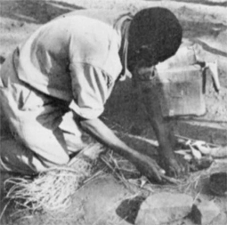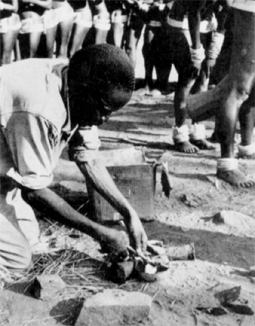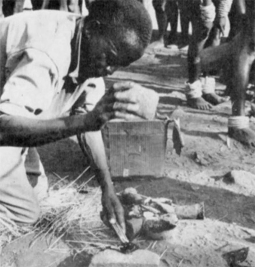| |
 - IRON-WORKING (lit. IRON ORE) - IRON-WORKING (lit. IRON ORE)
This was described as pfunzo (lesson), on account of the hoeing which follows the show of iron-smelting. I shall describe the show as performed at Thegwe in 1958. It was by far the longest and most involved of all the rites and shows of domba.
It requires careful preparation, and the master and his assistants recruited four or five senior novices. First, the master made a clay porcupine (nungu), into which he carefully placed straw 'quills'. Three 'quills' were placed close together in the porcupine's tail. He then made three small clay models of a blacksmith's 'bellows' (mivuvha) and stuck into them 'pipes' (mifhalana) of the castor oil plant (mupfure, Ricinus communis L.).
|

Nungu (the porcupine). Tshimbiluni Makumbila prepares the porcupine, which will be hunted by the novices in the evening. Note the three 'quills' in the back of the clay model. |
The girls pounded some burnt wood, and mixed the black powder with water in a small gourd. This was used both to paint the porcupine's head, and later for the making of hoes.
The master explained that in former times they would have been given a large gourd of beer while preparing the show. He then carved twelve miniature iron 'hoe-heads' of ancient design out of wood from a 'quinine tree' ( , Rauwolfia natalensis Sond.). He asked his assistant to cut some banana stalks and take them to the dancing-place. , Rauwolfia natalensis Sond.). He asked his assistant to cut some banana stalks and take them to the dancing-place.
|

The model forge is ready. The novices are supposed not to be looking, but some are cheating! |
After a while, the master went to the courtyard and started domba. While the girls danced, one of his assistants brought down the cardboard box in which he had placed his props. He took out the 'bellows' and arranged them, with the 'pipes' facing inwards, at angles of 120o. He then 'joined' them with a circle of clay, to make a 'smithy' (shondo). He put down the gourd of charcoal and water and the 'hoe-heads' wrapped in a bundle of grass (mufunzhe), and then he stopped domba and told the girls to keel down and face outwards. |
He took embers and ashes from the domba fire and poured them into the 'furnace' (  ). Then he tipped the 'hoe-heads' out of the bundle of grass onto the ashes, and told the girls to dance again. While they danced, he pretended to blow up the fire with the bellows. Taking a miniature pair of 'tongs' (lumano), he pulled out each 'hoe-head' in turn, dipped it in the charcoal mixture, placed it on a stone and hammered it (note). ). Then he tipped the 'hoe-heads' out of the bundle of grass onto the ashes, and told the girls to dance again. While they danced, he pretended to blow up the fire with the bellows. Taking a miniature pair of 'tongs' (lumano), he pulled out each 'hoe-head' in turn, dipped it in the charcoal mixture, placed it on a stone and hammered it (note). |

Tshimbiluni pretends to work the bellows. Note that the wooden 'hoe-heads' have been tipped into the 'smithy'. |
|

Tshimbiluni picks out a 'hoe-head' with the 'tongs' and dips it into the charcoal. Three completed 'hoe-heads' can be seen on the right. |
|

Tshimbiluni hammers a 'hoe-head' on a stone. |
|

The girls are supposed to be singing, but many are not, while Tshimbiluni fixes the 'hoe-heads' into 'hoe-handles' made of banana stalks. Notice his facial expression, intended to indicate professional expertise. The thin and thick sticks which are supposed to be held upright when the ritual domba song is sung, are at the feet of the assistant on the left. Part of the section that is cut, as a tally of the number of novices, may be seen. |
When he had prepared the 'hoe-heads', he began to fix them to the banana stalks which served as hoe-handles ( ). In each case, he took the thicker part of the stalk and made a hole in it with a little stick that represented an awl (murumbulo). Then he fixed in each 'hoe-head' with marvellous facial expressions that suggested great concentration and a very professional touch. Finally, he banged the distal end on the handle two or three times on a stone in order to fix the 'hoe-head', stood up, manipulated the 'hoe' with his foot, tested it for balance by going through the motions of hoeing, then put it aside and began to make another 'hoe'. ). In each case, he took the thicker part of the stalk and made a hole in it with a little stick that represented an awl (murumbulo). Then he fixed in each 'hoe-head' with marvellous facial expressions that suggested great concentration and a very professional touch. Finally, he banged the distal end on the handle two or three times on a stone in order to fix the 'hoe-head', stood up, manipulated the 'hoe' with his foot, tested it for balance by going through the motions of hoeing, then put it aside and began to make another 'hoe'. |
While he was making the 'hoe-heads', he stopped domba and intoned Domba Song No. 12. He hammered the 'heads' on the stone in time to its slow rhythm.
There is a song which was used by iron-workers when they had difficulty in getting their iron out of the pit. This song, Domba Song No. 13, used to be sung during  , according to a very old master of domba. , according to a very old master of domba.
|
|